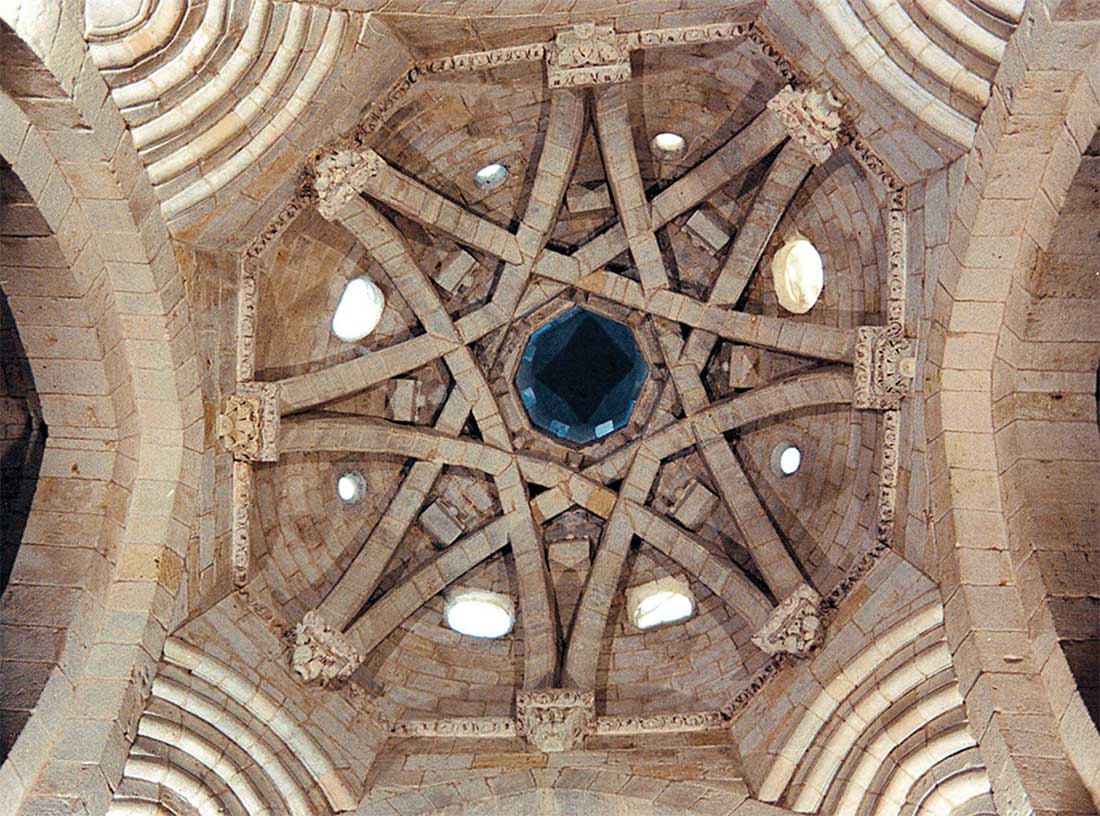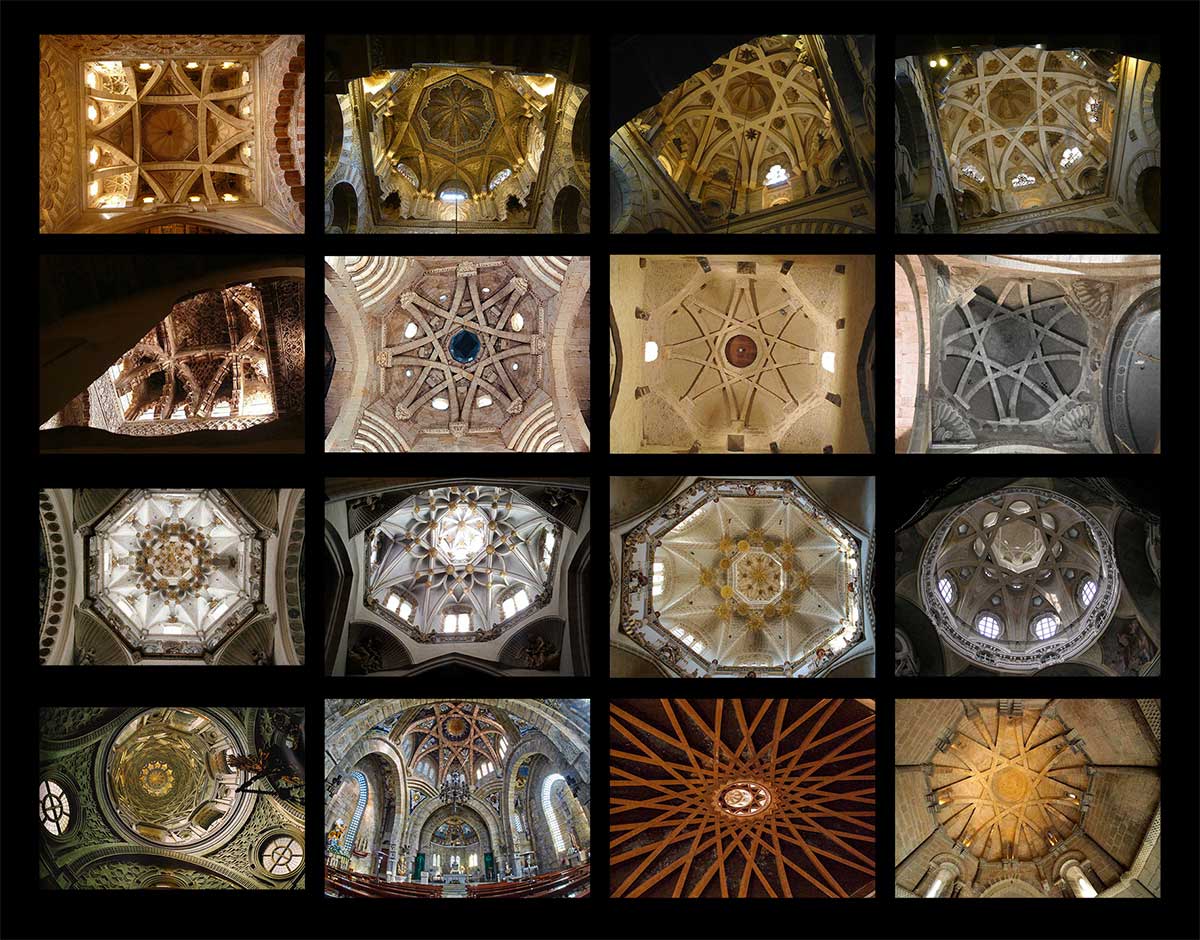We could very well find the true value and quality of any given creation by taking a look at how frequently that particular creation is reproduced and/or imitated throughout time. The Córdoba Mezquita is one of the great architectural heritages the Arabs left in Spain. And this is certainly not by mere chance or accident but instead due to the architectural advances that were implemented in its construction by the Muslims. This turned the Mezquita in much more than a praying place: a monumental source of technical inspiration.
It is the case of the ribbed vault: where a vault is built intersecting four barrel vaults resulting in eight edges in the shape of a star; the number of edges are always multiple of four. Because the different barrel vaults do not conjoin in the center of the vault there is some free space that allows for a smaller vault to be built.
This technical innovation was replicated all over the Mediterranean. But let us go through some examples.
THE ORIGINALS.
Let us begin in Córdoba. The first ribbed vault was built by Abd al-Rahman II around 960; it is now part of the Villaviciosa Chapel. It is easily noticeable how the main vault is made of several smaller vaults.

Soon after that, around the year 980, Al Hakam II begun to build the Mihrab and its famous vault of golden tesseras. At each side of the Mihrab two astonishing ribbed vaults where built.



Then the Royal Chapel built under Christian rule after the conquest of the city within the very same Mezquita. Its construction dates from the XIVth century. The vault was made in wood with Mudejar craft techniques such as the muqarnas decorating it.

FIRST ENLARGEMENT
We may never know for sure how many vaults were lost to wars, but we do know that this practical and aesthetic solution of the ribbed vault quickly influenced the entire Islamic world. Around the year 999 the mosque of Toledo was built, nowadays known as the Cristo de la Luz Chapel (Christ of the Light), an amazing construction with nine ribbed vaults. The Córdoba formula continued its expansion influencing the Aljafería Palace of Zaragoza, the minaret of the Kutubiyya Mosque in Marrakesh, the Alcazar of Seville or the Great Mosque of Tlemcen among others.

EL CAMINO DE SANTIAGO (THE WAY OF SAINT JAMES)
This pilgrimage would eventually cross the Pyrenees and take this technique to the rest of Europe.
The church of San Miguel de Almazán in Soria is a church of Romanesque origins that has also several other techniques and architectonic fashions. Its construction begun around the XIIth century and inside we can easily appreciate a vault of Islamic technique.

The Navarra Romanesque building such as the Santo Sepulcro (the Holy Sepulchre) de Torres del Río, Santa María de Eunate and the Holy Spirit of Roncevaux constitute a group of buildings of special interest. Also a Mozarab chapel can be found inside the cloisters of the Old Cathedral of Salamanca; just like so many other examples.

In France the Church of Sainte-Croix is a building dating from the XIIth century located in the city of Oloron-Sainte-Marie, in the French province of Pyrénées-Atlantiques, again there we find a ribbed vault of Islamic inspiration. Or the church of L'Hôpital-Saint-Blaise also dating from the XIIth century.


MÚDEJAR
There are plenty of other breathtaking constructions in Aragón for mudéjar art was deeply embedded here leaving us beautiful examples such as the lantern tower of the Seo de Zaragoza (Cathedral of the Savior).

Or the lantern tower of the Teruel Cathedral, or the Cathedral of Tarazona, both built following the technique and fashion of the Cathedral of the Savior of Zaragoza.


RENAISSANCE
The Italian architect and mathematician Guarino Guarini designed for the church of Saint Lorenzo of Turin a ribbed vault very similar to the one we find in the Mirhab of Córdoba. But he would then go further in his project to build the vault of the Cappella della Sacra Sindone which is part of the apse of the Cathedral of Turin and one of the most interesting vaults in the world.


SIGLO XX
The Templo votivo del Mar de Nigrán (Temple of the Nigrán Sea) was designed by the architect Antonio Palacios, who had previously designed the Communication Palace and the Círculo de Bellas Artes in Madrid. The temple was build between 1932 and 1937. It is the first stained glass using a Dalle de verre technique in Spain, that is a stained glass set on a concrete matrix.

The Laboral University of Gijón was built between 1946 and 1956 and was designed by the architect Luis Moya, it is the biggest building ever built in Spain: 270,000 m². Inside the interior of the church has a dome weighting approximately two thousand three hundred tons, and twenty pairs of ribbed vaults hold the entire structure without using a single column.

Well, that is all for now! A small token of how important the old secrets and arts built into the Mezquita of Córdoba were, and still are, for architects. An ancient building forever present in a history written in a thousand tongues.

